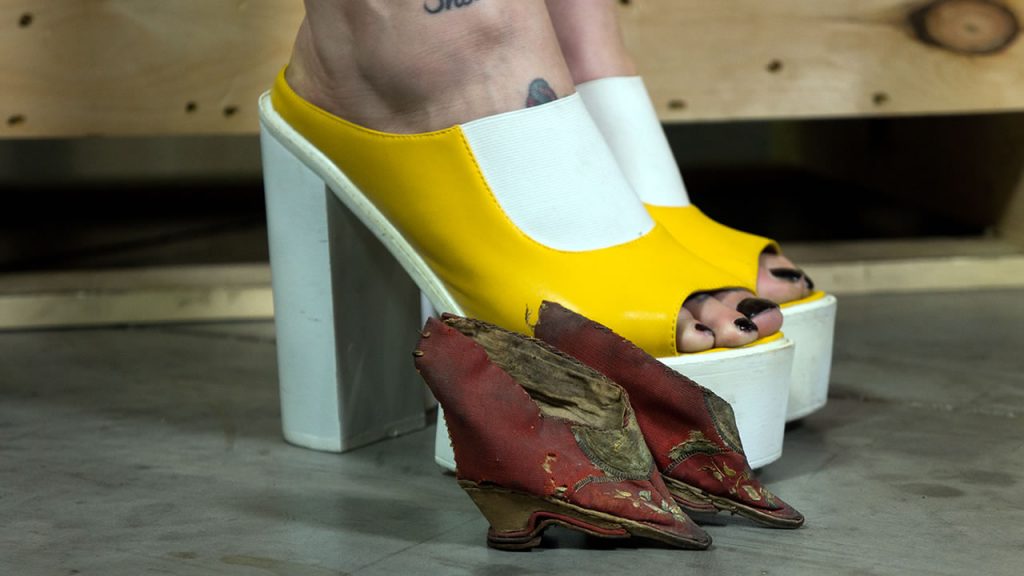Winner of the Fall 2016 StMU History Media Award for
Best Use of Scholarship
Best Article in the Category of “World History”
Best Use of Primary Sources
When I knew I couldn’t suffer another moment of pain and tears fell on my bloody bindings, my mother spoke softly into my ear, encouraging me to go one more hour, one more day, one more week, reminding me of the rewards I would have if I carried on a little longer. In this way, she taught me how to endure—not just the physical trials of footbinding or childbearing, but the more torturous pain of the heart, mind, and soul.1
More often than necessary, women are consumed with the idea of infatuation. Every culture has its own form of standards that pertain to women and what constitutes beauty. Although the world is slightly more accepting now, women used to go to extreme lengths to achieve an image that would be deemed attractive. In the Chinese culture, foot binding was that well-known beauty expectation for centuries. What started off as a celebrity fad, turned into a way of determining social status and eventually an all-around beauty expectation. 2 The objective of foot binding was for women to have the smallest foot possible, starting at very young ages. Not only was this a painful process for girls as young as five years, but it also promoted the idea that women must mutilate their bodies to become appealing to men. At some point in time, women began to just accept that this was something that was supposed to be done in order to be attractive. Often referred to as “lotus boats” or “golden lotuses,” bound feet started as a fad for the famous, and slowly made its way to becoming the social norm.3

This practice began around the tenth century with women in the entertainment business. These women were adored for their tiny arched feet and were seen by men to be much more attractive than middle class women with average feet. As these dancers were gaining an audience, the idea of “lotus feet” was becoming familiar. Not long after these performers expressed their “beauty,” foot binding became a norm for women who wanted to fit in and even for those who had a desire to find a husband.4 This painful process consisted of the breaking of young girl’s toes to form the desired triangular shape. Then the arch of the foot would be bent horizontally from the toes all the way to the heel. As if this was not painful enough, the girls were forced to walk on their feet to intensify the arch, breaking the foot even more. After all of this, the foot would be wrapped to maintain the shape of it as well as prevent any sort of deviation.5

Although this practice was around for centuries, it was only a matter of time before someone realized how inhumane and cruel it really was. Thankfully, many people began to protest against foot binding, forming “anti-foot binding organizations” to raise awareness on the inhumanity of binding women’s feet. By the 1950’s, laws were passed, allowing women to unbind their feet. Although hesitant at first, the trend slowly declined. Many women protested to unbinding their feet, due to the fact that it had been a social norm a thousand years. However, the movement against foot binding continued and eventually the last of the factories that make the tiny shoes were shut down, disabling the women from continuing the custom. Today, foot binding is no longer practiced and the only women who continue to maintain the tiny feet are those elder women who refuse to let go of the past.6
- Lisa See, Snow Flower and the Secret Fan (New York: Random House Publishers, 2005), 3-4. ↵
- Yaodong Gu et al., “Foot Loading Characteristics of Chinese Bound Feet Women: A Comparative Analysis,” PLoS ONE 10, no. 4 (April 2015): 1–9, doi:10.1371/journal.pone.0121695. ↵
- Yu-ning Li, Chinese Women Through Chinese Eyes (New York: Routledge, 2015), 125-127. ↵
- Women in the Middle Ages: An Encyclopedia, 2004, s.v. “Footbinding (Late 10th Century-early 20th Century),” by Patricia Buckley Ebrey. ↵
- Amanda Foreman, “Why Footbinding Persisted in China for a Millennium,” Smithsonian, accessed November 8, 2016, http://www.smithsonianmag.com/history/why-footbinding-persisted-china-millennium-180953971/. ↵
- “Women with Bound Feet in China,” Reshaping the Body: Clothing & Cultural Practice, accessed November 8, 2016, http://exhibits.hsl.virginia.edu/clothes/lady_bound/. ↵



189 comments
Hailey Rodriguez
Before reading this article I had never heard of this practice used by Chinese women. I can’t possibly imagine the pain they forced themselves to endure in order to be deemed socially acceptable. Reading about how they would begin this process on children as young as 5 years old by breaking their toes and bending their feet makes me realize to what extreme lengths humans go to fit in. This practice is truly inhumane.
William Ward
I understand wanting to stand out in our massive world but sacrificing comfort in such a critical area is deranged. I have felt the pain in wearing shoes that are sizes to small, with cramps, aches, and just a general feeling of discomfort are common. A society that required women to deform their feet is beyond cruel when it is pushed to a level it becomes permanent. A terrible, cringe-y trend that have been outlawed sooner.
Damian Jennings
I have heard of this practice done by women, binding their feet to meet a desirable look, only for the satisfaction of men. It’s unremarkable how convinced women were to this custom, they would willingly go through pain without questioning the process. This procedure was deemed normal for women, but society finally came to its senses and protested against the inhumane culture that these women became accustomed to. In an effort to rid this practice people formed anti-foot binding organizations, during the late 1950s a law was passed allowing women to freely bind or unbind their feet.
Mia Stahl
Whether we choose to recognize it or not, foot binding is the result of the patriarchal ideologies of the Chinese being held as the pinnacle of a strong government. Something this article didn’t mention was one of the main reasons men thought women should bind their feet. This reason was foot binding made it extremely difficult, if not impossible, for women to run away when their husbands beat them. Foot binding was not only something pretty for men to look at but was also a strategic way that they were able to keep their toxic power over women.
Luis Magana
The result of female foot binding isn’t a very pretty one. Women forced into shoes smaller than the size of my hand is so cruel. These Chinese women underwent so much pain in order to just fit into society and be seen as more appealing to men. Im relieved this tradition is no longer being practiced but it really shows how the overall view os society is changing as well as some traditions are being changed.
Andrea Cabrera
The very first time I heard about this was in a story from our literature book on 8th grade of an Asian little girl wanting to be a ballet dancer, but her grandmother mistaken her slippers with strings they used to bend their feet. It’s very introspective to learn all the things women must go through to achieve what their society standards believe is “beautiful”. Even if foot bending is no longer a practice, today’s society still go through various aesthetic surgeries or make up trends just to comply what is believe to be perfect around the time and since beauty standards keep changing sometimes these procedures are irreversible and shouldn’t be recommended.
Kaitlyn Killebrew
I remember learning about this in World History. I can handle a lot of things, graphic movies, gore, all sorts of things but foot binding will forever cause my toes to curl. It’s terrifying to think the of lengths of which women would go through to be considered “beautiful”. I am so thankful that this is no longer a practiced traditions but that doesn’t mean that we still don’t have crazy ways of maintaining beauty. A common practice in Eastern Asia is double eyelid surgery to create a significant separation between the eye and the eye lid, and even going so far as bleaching skin to make it lighter. Bleaching hair is already damaging enough, but we don’t even the long term effect of skin bleaching yet. It makes me scared for the “standard” of beauty in the future.
Harashang Gajjar
These changes can be illustrated by the practice of female foot-binding. Some early evidence for it comes from the tomb of Lady Huang Sheng, the wife of an imperial clansman, who died in 1243. Archaeologists discovered tiny, misshapen feet that had been wrapped in gauze and placed inside specially shaped “lotus shoes.” For one of my pieces on camera, she balanced a pair of embroidered doll shoes in the palm of my hand, as she talked about Lady Huang and the origins of foot-binding. When it was over, which turned to the museum curator who had given me the shoes and made some comment about the silliness of using toy shoes. This was when she was informed that she had been holding the real thing.
Daniela Martinez
The title of the article is simple yet captivating, I was intrigued from the start. I’ve previously heard about the practice of foot binding but didn’t know how it originated. It is crazy to think that many Chinese women underwent such a painful process in order to fit in and appeal to men. I find it extremely repulsive that this was a practice that was encouraged from a very young age in women only to live up to the beauty standards of the time and how long it took to for many to realize that foot binding was inhumane. I liked how the article notes that this is no longer a common practice among Chinese women but highlights the fact that there are a few individuals that refuse to let go of the past.
Marina Castro
The foot binding practice is very intriguing. It’s hard to imagine that women and men could consider it to be appropriate. It is impressive how far women will go to fit the beauty standard, and it is impressive that such standards exist. Sadly, modern society still has practices that push women into changing their bodies to look certain way. What should be eradicated are not the practices, but the thought of having to look all the same.